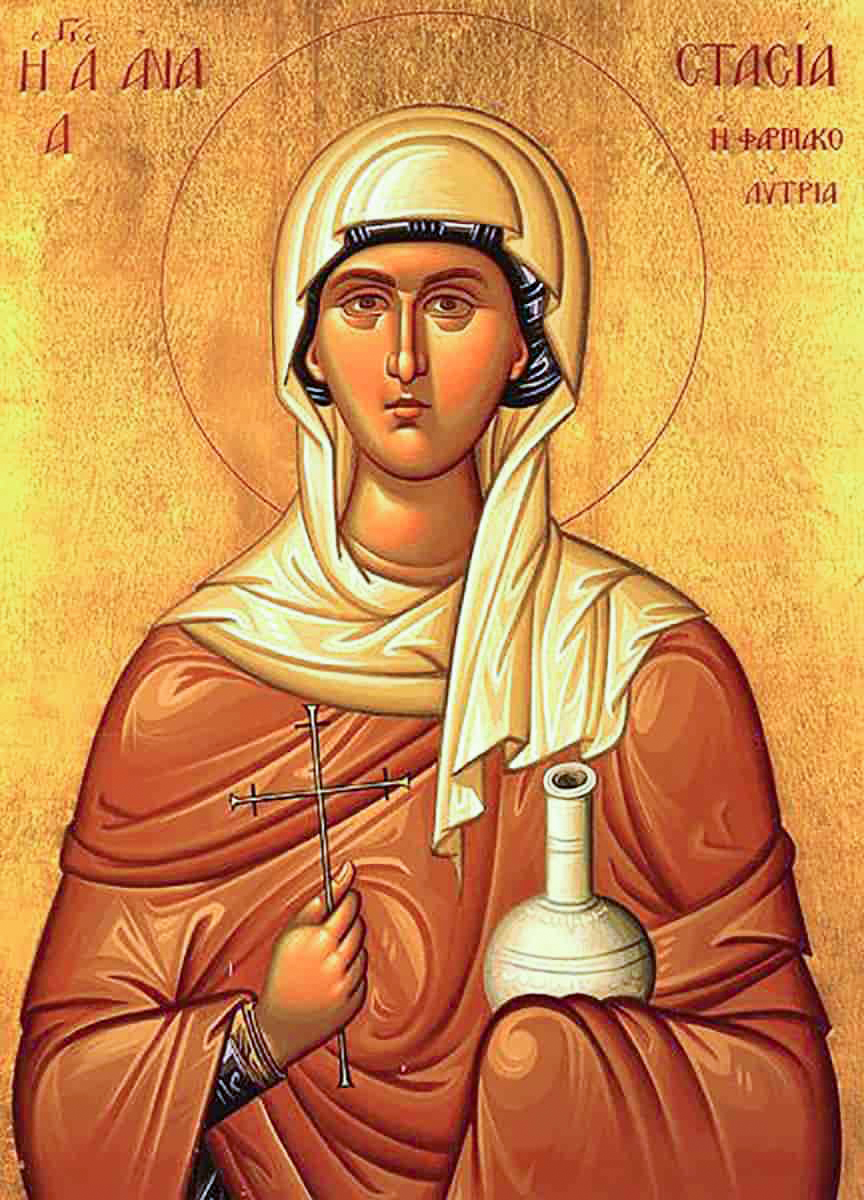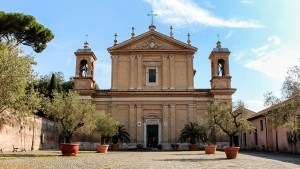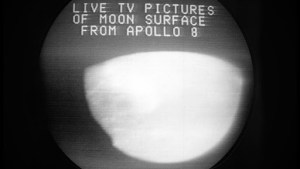These days, St. Anastasia of Sirmium does not enjoy a particularly widespread popular devotion in the West. So how is it that not one but two icons of the saint have been in orbit around the earth?
In the Middle Ages, Anastasia of Sirmium was one of the most popular saints in the world, in the West as well as in the East. Born in Rome in 281, the young girl found a valuable spiritual father in St. Chrysogonus, who was her teacher. But when she was little more than a teenager, the saint was imprisoned, a victim of anti-Christian persecution. In jail, he was subjected to every form of harassment. Anastasia, deeply affected by the suffering her friend had to endure, vowed to herself that from then on she would devote her entire life to the assistance of prisoners.
At that time, a violent anti-Christian persecution was reaping victims in the Balkans. Anastasia wanted to reach that land of martyrdom and took up residence in Sirmium (present-day Sremska Mitrovica, Serbia). Putting to good use the wealth she had inherited from her parents, the saint spent several years of her life assisting (with food, prayers and moral comfort) Christians who were in prison. Such solicitude proved suspicious to the authorities, who investigated the woman and discovered that she was also a Christian; courageously, in the presence of the judges, Anastasia made a profession of faith and thus went to her martyrdom. It was December 25, 304.

A Roman widow of the 4th century, after her husband’s death she dedicated her life to acts of charity and the practice of her Christian faith. During the persecution of Diocletian she was killed for her beliefs. Her feast was originally placed on December 25 and it was customary to commemorate her in a small way each Christmas.
Devotion to St. Anastasia: as strong in the East as in the West
By the end of the 4th century, a church dedicated to the martyr had already been erected in the city of Sirmium. The devotion spread rapidly throughout the Balkans, but did not remain confined to the peninsula: in 467, Constantinople asked to have a share of the relics. By the end of that century, St. Anastasia was popular throughout Pannonia.
Theodoric, who conquered Italy in the 5th century giving rise to the Ostrogothic kingdom, was also from Pannonia. The ruler brought with him many of the traditions of his homeland, including veneration of the saint of Sirmium. As devotion spread widely throughout Italy (and, from there, throughout the West) missionaries also began to speak of her in the lands they were evangelizing in the East: Crimea, Moravia, Russia, and Bulgaria. By the 10th century, the martyr of Sirmium was known (and beloved) throughout Europe. Her name even appears in the Roman Canon (Eucharistic Prayer I)
As the centuries passed, popular devotion to St. Anastasia slowly began to wane in the West (remaining, however, very much alive among the faithful of the Orthodox confession). But the saint was able to find a way to start making waves again. Indeed, in 1995 she unexpectedly became the protagonist of an initiative that even took her into orbit around the earth!
Despite the Cold War, St. Anastasia was uniting hearts
It all began in Sale San Giovanni, a small village in the Italian region of Piedmont in which stands a Romanesque church dedicated precisely to St. Anastasia. There, in 1988, some valuable frescoes dating back to the 13th century were discovered under a layer of lime. The discovery had an international echo and aroused in particular the curiosity of some Soviet artists (coming from an area where depictions of St. Anastasia were very frequent in iconography).
Under the direction of the Italian Superintendence for Artistic and Historical Heritage, the Piedmont Region and the Russian Federative Republic collaborated to coordinate a restoration project that, between 1991 and 1992, was carried out by a team of professionals of both nationalities. And so, between the arches of the little church in Sale San Giovanni, one of the first international collaborations between a NATO country and the USSR (by then in the process of dissolution) took place. While the restoration project in itself was certainly small, it caused a stir because it was highly symbolic.
The mission “Saint Anastasia – a Hope for Peace”
This international friendship was the seed from which the project “St. Anastasia – a Hope for Peace” took off: one of those stories that make us suddenly feel old, as if the events we are about to describe were echoes of a long-lost time.
Instead, there are only three decades that separate us from those 1990s when Europe watched, astonished, the outbreak of the Yugoslav war. But the detail that seems most foreign to us today is the fact that at the time, in a climate of progressive détente, Russia and the EU stood side by side as they watched the war raging just a few miles from them.
Since religious differences (between Christians and Muslims, but also between Catholics and Orthodox) had played a significant role in the various ethnic groups living among the Balkans fighting against each other, the Christian churches that were in the territory liked the idea of invoking St. Anastasia to ask for the grace of a speedy resolution of the conflict.
And the international community too soon realized that, indeed, that saint (who was beloved by Catholics as well as Orthodox, and who had been martyred in the very areas that were at war) seemed to be the perfect saint to whom prayers for peace could be directed.
Then there was that beautiful news story that had seen Russian and Western restorers working side by side in a friendship that, at the time, embodied every diplomat’s dream. In short: through international cooperation, work began on a project that, in a gesture with symbolic significance, would send into space an image of a saint who had lived in Serbia. After all, every astronaut says that wars and divisions seem even more meaningless when you’re looking at the Earth from space.
The MIR space station gladly agreed to host a small icon of the saint for some time. Or rather: it agreed to host two of them, to symbolically give space to the two different iconographies (the Western and the Eastern) in which the image of the saint had taken root. Iconographer Nikolai Gaverdosvki wrote an icon in full Russian style, following the style of the Jaroslav school; and artist Nadia Lavrova created an image of the saint inspired by the frescoes of the Piedmontese chapel and embroidered it on fabric with gold, silver, and silk threads.
Pope John Paul II and Patriarch Alexis II of Moscow both blessed each of the two icons which were later loaded onto the Progress-33 spacecraft on July 22, 1995, taking flight to the MIR station. A few days later, they were presented to the world by two of the cosmonauts who were part of the mission and who, on the occasion, once again reiterated their call for peace. The two images of the saint remained in orbit for seven months, making 3,000 orbits around the Earth.
Saint Anastasia of Reconciliation
At the end of the space mission, the two icons returned to our planet. But that didn’t mean they stopped traveling; rather, under the patronage of UNESCO, they made a nearly 10,000-mile pilgrimage, visiting the main places associated with the devotion of St. Anastasia.
It was everyone’s desire for the journey to end in Sremska Mitroviza, the Serbian town where the saint had been martyred and where they hoped to build a chapel celebrating the successful pacification. Unfortunately, the persistence of tensions made the realization of this dream impossible. Instead, a small wooden chapel, which had already been planned in the meantime, was built in Piedmont on the Hill of Santa Maria. Symbolically, the tiny church was dedicated to St. Anastasia of Reconciliation; it can still be seen today.
Sadly, much has changed since that day, but that doesn’t make this story less valuable. Indeed, paradoxically, it perhaps turns it into something very relevant. What better time than now to rediscover the figure of St. Anastasia of Reconciliation?



